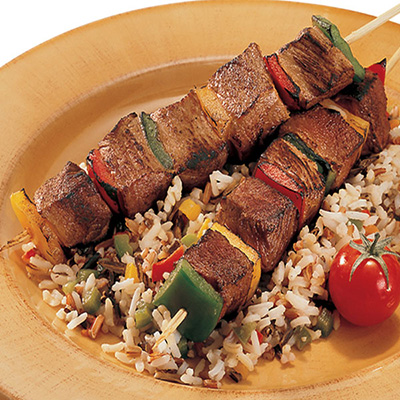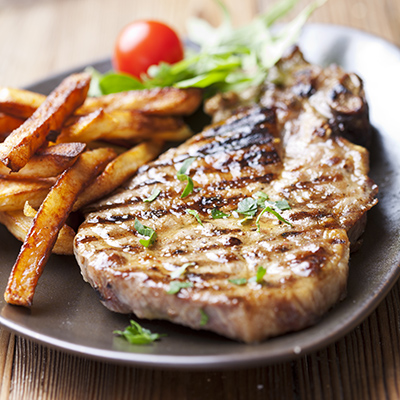All About Boar

Boar has always been considered a choice game meat, prized for its leanness and versatility. It works particularly well with ginger, garlic, thyme, rosemary, basil, mace and small fruits.
Tips and advice for cooking boar

- Boar meat is lean with only slight marbling in the shoulder cuts. Consequently, it should be cooked at lower temperature than beef and for a shorter amount of time.
- If you prefer your meat well done, opt for cuts that can be braised. Any other cut will become tough if cooked to well done.
- If you buy a whole baby boar to roast on a spit, keep in mind that the loin and the shoulder do not cook in the same amount of time as the rest. The internal temperature should reach 80°C (176°F). Figure at least 680 grams (1½ lbs) of meat per person.
- Boar meat can also be prepared as a terrine, or a stew served with raspberry or chestnut vinegar.
Expert Tip
Contrary to other farm-bred meats or wild meats, boar meat should not be left standing after it is removed from the oven. It will lose all of its juices as well as its tenderness because it is so lean.
Cooking methods
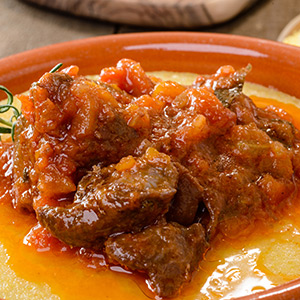
Fillet
- Because it is small, generally about 300 grams (11 oz), it should be cooked whole.
- In a pan, sear quickly over high heat, 90 seconds per side.
- Transfer to a 160°C (320°F) oven and cook for 10 to 15 minutes.
- To avoid the formation of a crust, do not baste during cooking.
- Add a bouquet garni to the cooking pan and sauté lardons, onions and cashew nuts.
- Deglaze with beer.
For a more sophisticated presentation:
- Cut a slit inside the fillet and season.
- Add a few strips of foie gras, close and tie to secure.
- Sear the meat on all sides in a little oil and butter.
- Transfer to the oven for 10 to 15 minutes.
- Serve with pears poached in mulled red wine made with cinnamon, nutmeg and cloves.
Loin
- The loin comes in three cuts:
- The rack, which is seared in a pan and then transferred to the oven for 45 minutes per kilo.
- The roast, which is slit open and stuffed with sharp goat cheese and closed before being seared in a pan and transferred to the oven until it reaches an internal temperature of 75°C (167°F). Coat with Dijon mustard or honey and herbs.
- The medallion, which is cooked quickly on high heat either on the stovetop or on the barbecue. Turn the medallions as soon as blood begins to pearl on the surface.
- Deglaze the pan with fruit liqueur, red wine or maple syrup.
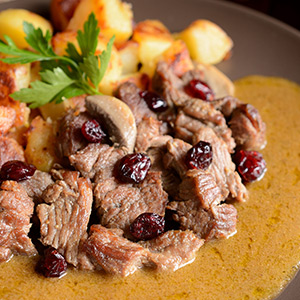
Sirloin and inside round
- Roasts or steaks are available at your local Metro butcher’s counter. Cook the same way as loin.
Outside round
- Cut in cubes, this muscle is tough and must be marinated for many hours in fruit wine, full-bodied red wine, port or cider.
- Season cubes with fresh-ground peppercorns and lemon zest. Insert slivers of garlic.
Whole leg or haunch
- This is the perfect cut for roasting on a spit or in the oven. It can serve up to 15 people.
- Suggested marinade: use equal amounts of water and maple syrup, then add pepper, garlic and Worcestershire sauce.
Flank
- Spare ribs. Because they are not very meaty, patience is a must. The ribs should first be simmered for two hours, then braised for another two hours.
- Ground flank can also be shaped into burger patties and cooked on the barbecue.
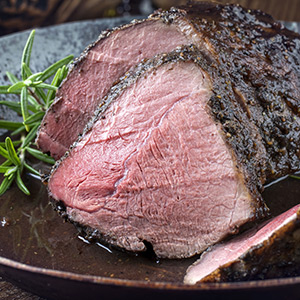
Shoulder
- The shoulder is used to make stewing cubes for slow cooking. If you’re using a recipe that calls for a different red meat, such as beef, remember to cut the cooking time in half for boar.
- Coat cubes of meat with seasoned flour.
- Brown cubes in a small quantity of oil.
- Add aromatic vegetables and spices such as pepper, thyme, bay leaf and juniper berry.
- Add enough liquid to cover the meat completely.
- Cover and simmer over medium heat, 60°C (160°F).
- The meat of the shoulder is slightly marbled so it also makes a delicious roast.
- Cook like other roasts, removing from oven when the meat thermometer indicates 70°C (140°F).
- Deglaze pan with broth or other liquid and reduce.
- Carve roast into thin slices and dip quickly in the sauce to caramelize the meat.
Shank
- Because it is very small, the shank should be braised or prepared as an osso buco.
How to know when cooked boar is done
Preheat oven to 160°C (320°F) and use a thermometer to determine cooking time precisely. For rare meat, the internal temperature should be 70°C (160°F). For medium pink, it should be 75°C (167°F).
Boar meat will continue to cook after it is removed from the oven so, if you like your meat pink, take it out when it it’s rare. If you like it rare, take it out when it’s blue!

Nutritional value
Boar is very low in calories, fat and cholesterol.
Storage
Fresh boar meat should be stored in its original packaging, in the coldest part of the refrigerator.
Steaks and roasts will keep for up to three days in the refrigerator and up to four months in the freezer.
Ground or cubed meat can be kept for one or two days in the refrigerator and up to two months in the freezer.











